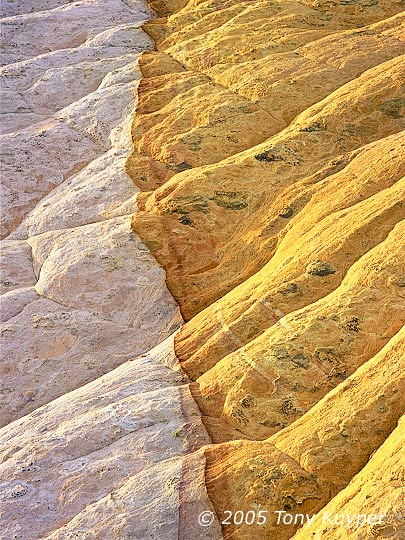Tony Kuyper Photography

Fluid Front
I took this picture simply for the intriguing color and geometry. At the time, I didn't have the slightest idea how it had formed. Since then I have received the following scientific explanation. I hope you are able to follow it and, not being a geologist myself, welcome corrections.
The rock is Navajo sandstone. It is basically a sand dune that over time has turned to stone as sand grains under pressure have cemented together. Chemically, sand is silica and essentially colorless. The yellow coloration of the rock is due to small amounts of chemical oxides that over time have percolated through the rock and deposited between the colorless grains of sand. But oxide-laden water isn't the only thing that has infiltrated this stone. After the color was laid down, subsequent fluid flows containing reducing agents flowed through parts of the rock. The reducing agents dissolved the colored oxides and carried them away. The white-colored rock in the image has essentially had its colorant bleached out by this process. There is a dark line of pigment between the yellow and white parts of the rock. This represents the fluid front, the fartherest that the bleaching solution was able to penetrate. At this edge, the dissolved pigments came out of solution forming an intensely colored band. Eventually, erosion uncovered the two-toned rock that we see today.
Knowing the science behind this scene does not diminish the mystery of its natural beauty. Quite the opposite. I am completely fascinated that such intricate patterns can be created by natural forces. While I realize that geologic processes occur without consideration for human perception, I have, nonetheless, frequently stood in awe of the delicate hand that they exhibit. In doing so, I find a connection for which I have few words. In my mind I know that nature was not made for me, but there are moments, when I am photographing seemingly impossible landscapes like this, that I can't help believing that it was.